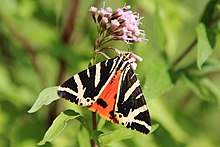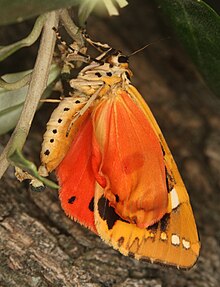Jersey Tiger
| Jersey tiger | |
|---|---|
 |
|
 |
|
| Scientific classification | |
| Kingdom: | Animalia |
| Phylum: | Arthropoda |
| Class: | Insecta |
| Order: | Lepidoptera |
| Superfamily: | Noctuoidea |
| Family: | Erebidae |
| Genus: | Euplagia |
| Species: | E. quadripunctaria |
| Binomial name | |
|
Euplagia quadripunctaria (Poda, 1761) |
|
| Synonyms | |
|
|
Euplagia quadripunctaria, the Jersey tiger, is a day-flying moth of the family Erebidae. The adult wingspan is 52–65 millimetres (2.0–2.6 in), and they fly from July to September, depending on the location. They tend to fly close to Eupatorium cannabinum, where they are hard to notice because of their camouflage.
The larvae (caterpillars) are polyphagous, feeding from September to May on nettles (Urtica) and raspberries(Rubus), dandelion (Taraxacum), white deadnettle (Lamium), ground ivy (Glechoma), groundsel (Senecio), plantain (Plantago), borage (Borago), lettuce (Lactuca), and hemp-agrimony (Eupratoria). The insect overwinters as a small larva.
Large groups of adults of subspecies E. q. rhodosensis can be found on occasion aestivating (sheltering from the summer heat) in Petaloudes, on Rhodes, in a place that has become known as the 'Valley of the Butterflies'.
Euplagia quadripunctaria is widely distributed in Europe from Estonia and Latvia in the north to the Mediterranean coast and islands in the south. It is also found in West Russia, South Urals, Asia Minor, Rhodes and nearby islands, the Near East, Caucasus, South Turkmenistan, and Iran (Dubatolov, 2010). Individuals are known to migrate northwards from their regular breeding grounds during the summer.
...
Wikipedia
